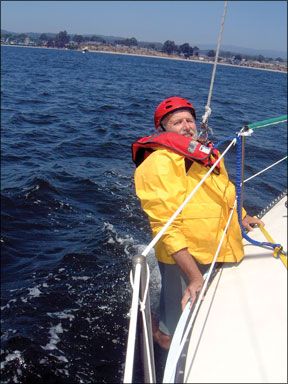During our testing a of a harness without a crotch strap, the harness did ride up on the victim, but there was no tendency for the wearer to slip out. If the waist strap is tighter than the wearers shoulder width, its not possible for him to slip out. This answer begs the question: What about people whose tummy is wider than their shoulders? Harness waist belts should be worn as taut as is comfortable. If that practice is followed, then crotch straps should not be needed.
***

288
When you hoisted the “victims” out of the water with a halyard during your recent harness test (“Clipped In: Safety Harness Showdown
,” December 2006), was there any tendency of the victims to slip out of the harness? As part of the Crew Overboard Symposium in San Francisco Bay in August 2005, I was wondering what you found with regard to the benefit of crotch straps during your tests?Capt. Henry E. Marx
Landfall Navigation
Although some people swear by crotch straps, many others do not like them.
Practical Sailor tester and veteran racer Skip Allan (one of the “victims” in the recent harness test) is one of the latter. His disdain for crotch straps, he says, is primarily due to the complexity of putting the whole thing on and adjusting it. When donning a harness is made more time-consuming, it is less likely that the harness will be used.During the
Practical Sailor tests, none of the harnesses evaluated had crotch straps. Testers made sure the harnesses were properly adjusted to prevent any victim from slipping out.While the harnesses did ride up on the victims, there was no tendency for the wearer to slip out. If the waist strap is tighter than the wearers shoulder width, its not possible for him to slip out. This answer begs the question: What about people whose tummy is wider than their shoulders? We assume the harness could become loose as it slips up, but we did not test this, so we cannot say whether the wearer would benefit from crotch straps.
Harness waist belts should be worn as taut as is comfortable. If that practice is followed, then crotch straps should not be needed.
Fuel Fumes
Recently, our Cal 40s bilge was inundated with a substantial amount of fuel due to a leaky fuel filter. Our bilge sump is 4 feet deep. The fuel has been painstakingly removed, but the odor remaining is unacceptable. Do you know of any reliable remedies?
Bob Peters
S/V Wings, Cal 40
Seattle, Wash.
To answer your question, we picked the brain of diesel pro Gordon Torresen, president of diesel repair and maintenance center Torresen Marine. He had this to say: “The only real answer is time. Obviously the odor is from residual fuel evaporating from the bilge, a very slow process in the case of diesel. Using good bilge cleaners-Star brite Super Orange Bilge Cleaner was Practical Sailors favorite in our 2006 cleaner test-and allowing them enough time to cut the diesel will speed the process. This means filling the sump as much as possible, adding bilge cleaner, agitating for as long as possible, and draining it well. Using a solar-powered vent and leaving everything open as often as possible will help. Leave the floorboards out to allow air flow in the bilge. Take anything that was used during the filter change and cleanup off the boat. Even cleaning the tools used for the job is required if you live aboard.
It only takes a drop of diesel to make a long-lasting stink; but eventually, evaporation will win.”





































